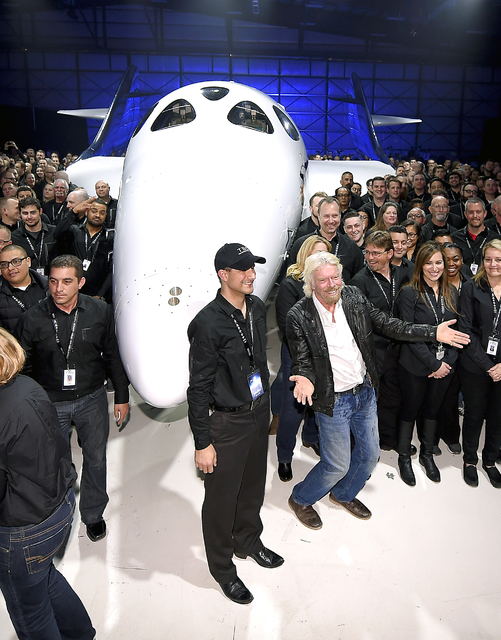MOJAVE, Calif. — Virgin Galactic rolled out a new version of its SpaceShipTwo space tourism rocket Friday as it prepares to return to flight testing for the first time since a 2014 accident destroyed the original craft, killing a pilot
MOJAVE, Calif. — Virgin Galactic rolled out a new version of its SpaceShipTwo space tourism rocket Friday as it prepares to return to flight testing for the first time since a 2014 accident destroyed the original craft, killing a pilot and setting back the nascent industry.
A Land Rover with Virgin Galactic founder Sir Richard Branson standing through the sunroof pulled the ship in front of an audience inside a hangar at Southern California’s Mojave Air &Space Port, where it was assembled.
Branson’s 1-year-old granddaughter, Eva-Deia, helped by her mother, christened the craft by breaking a little bottle of milk over its nose. The baby is the daughter of Branson’s son, Sam, and his wife, Bellie.
“All of us in this room need to pinch ourselves … isn’t she quite beautiful,” Branson told the audience.
The ship is the size of a small corporate jet. It was named Virgin Spaceship Unity at the suggestion of theoretical physicist Stephen Hawking, whom Branson promised a free ride into space.
SpaceShipTwo is designed to be flown by a crew of two and carry up to six passengers on a high-speed suborbital flight to the fringes of space. At an altitude above 62 miles, passengers will experience a few minutes of weightlessness and see the Earth below.
After years of development, Virgin Galactic appeared to be nearing the goal of turning ordinary civilians into astronauts when the first SpaceShipTwo broke apart on Oct. 31, 2014, during its fourth rocket-powered flight. Wreckage fell to the Mojave Desert floor.
“When we had the accident, for about 24 hours we were wondering whether it was worth continuing, whether we should call it a day,” Branson told The Associated Press. He said engineers, astronauts and members of the public helped convince him that space travel is too important to give up on.
The crash investigation found that co-pilot Michael Alsbury prematurely unlocked the so-called feathering system that is intended to slow and stabilize the craft as it re-enters the atmosphere. Alsbury was killed, but pilot Peter Siebold parachuted to safety.
The “feathers” — a term derived from the design of a badminton shuttlecock — are tail structures that extend rearward from each wingtip. They are designed to swivel upward at an angle to create drag, preventing a buildup of speed and heat, and then rotate back down to normal flying position as the craft descends into the thickening atmosphere.
Company officials said that the new spaceship will have a device to prevent a similar pilot error. The company stressed in a statement its commitment to testing from the level of individual parts on up to the complete craft.
“Our team’s job is to plan out not just the obvious tests but also the strange and inventive ones, to conduct those tests, and to use the data from those tests to re-examine everything about our vehicle to ensure we can take the next step forward,” it said.



